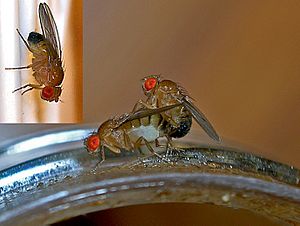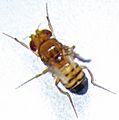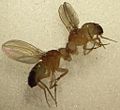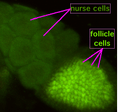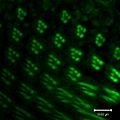Drosophila melanogaster facts for kids
Quick facts for kids Drosophila melanogaster |
|
|---|---|
 |
|
| Male Drosophila melanogaster | |
| Scientific classification | |
| Kingdom: | |
| Phylum: | |
| Subphylum: | |
| Class: | |
| Order: | |
| Family: | |
| Genus: | |
| Binomial name | |
| Drosophila melongaster |
|
The Drosophila melanogaster is a small, common fly that you often see near rotting fruit. It's also known as the fruit fly. For over 100 years, scientists have used this tiny fly to study genetics and how animals behave.
Contents
Why Fruit Flies Are So Important
In the early 1900s, a scientist named Thomas Hunt Morgan started studying Drosophila. He and his team made a huge discovery: they found out about genetic recombination. This is when pieces of DNA swap places during reproduction. This discovery made the small fruit fly super important in genetic research.
Scientists still use Drosophila today because they are small and easy to keep. They also have a very short "generation time," meaning they grow from egg to adult very quickly. This helps scientists study many generations in a short time. We even know the fruit fly's entire genome, which is like a complete instruction manual for building the fly. Hundreds of its genes have been found and studied.
Life Cycle of a Fruit Fly
You can easily find fruit flies in nature, but many science companies also sell them. These companies offer different kinds of fruit flies, including ones with special mutations. They also sell all the tools you need to take care of the flies. It's usually not very expensive, and most of the equipment can be used again and again.
How Fruit Flies Behave
Amazing Vision
A fruit fly's vision is its most important sense. About two-thirds of its brain is used just for seeing! Even though they can't see fine details as well as humans, they are much better at timing things, like when they fly.
The fruit fly's eye is a compound eye, made of 760 tiny units called ommatidia. Each of these units has eight cells that detect light, plus support cells, pigment cells, and a lens. Normal, or wild-type, fruit flies have reddish pigment in their eyes. This pigment helps to soak up extra blue light so the fly isn't blinded by bright light.
Fast Flight
A fruit fly's wings can beat incredibly fast, up to 220 times every second! When flies fly, they move in straight lines and then make very quick turns. These quick turns are called saccades. During a saccade, a fly can turn 90 degrees in less than 50 milliseconds, which is faster than you can blink!
Scientists used to think that the stickiness of the air was the main thing affecting how fruit flies fly. But new research shows that flies make banked turns, just like airplanes. They speed up, slow down while turning, and then speed up again. This means that the fly's own weight and how it moves (called inertia) are more important for its flight than the air's stickiness.
Reproduction
To mate with a female fruit fly, the male fruit fly performs a special dance.
- He first faces the female.
- Then, he follows her around.
- He gently taps her on the leg.
- He vibrates one of his wings.
- He positions himself behind the female's abdomen.
- Finally, the male tries to mate by curling his abdomen under hers. The female can, however, kick the male away with her legs if she doesn't want to mate.
Mating usually lasts about 15 to 20 minutes. During this time, the male releases hundreds of long sperm into the female's body. The female then stores these sperm. After a few days, she can lay about five eggs.
Images for kids
See also
 In Spanish: Drosophila melanogaster para niños
In Spanish: Drosophila melanogaster para niños


